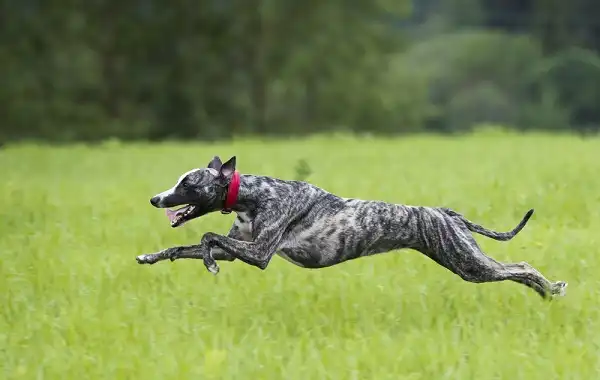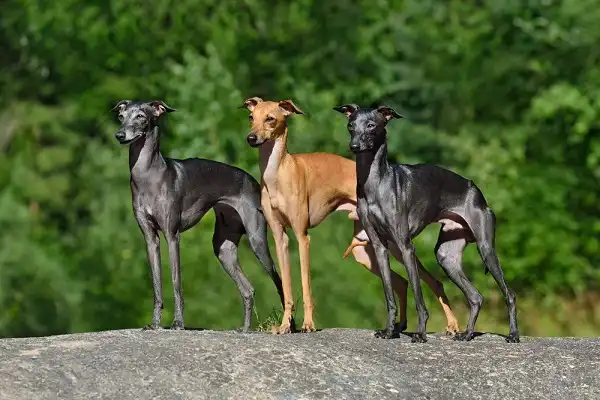If you’re looking for an excellent companion, consider adopting a greyhound. Adaptable, loyal, and eager to please, these strong and graceful animals can turn into the perfect pet for people of all ages. From their low grooming needs and calm temperaments to their active personalities that love long walks – adopting a greyhound offers endless benefits without much cost or hassle associated with larger animal breeds. Read on to find out why not just athletes love this breed but regular dog lovers do too!

Greyhound Description
The Greyhound is a breed of dog that is well-known for its speed, agility, and grace. Originally bred for hunting and racing, greyhounds are now often adopted as family pets. They are typically medium to large-sized dogs with a slim, muscular build and short coat that comes in a variety of colors, including black, white, fawn, brindle, and red. One of the most appealing aspects of owning a greyhound is its low grooming needs. They have short fur that sheds very little and requires minimal brushing, making them easy-to-care-for pets. Greyhounds are also generally healthy dogs, with few common health issues. In addition to their physical attributes, greyhounds also have unique personalities that make them a joy to be around. They are also highly intelligent and respond well to positive reinforcement training. Overall, the greyhound is a wonderful breed of dog that offers endless benefits for those who choose to adopt one. Whether you are looking for a loyal companion or an active lifestyle partner, a greyhound may be the perfect addition to your home.
Greyhound Habitat
Greyhounds are adaptable dogs that can thrive in a variety of living situations. While they may have been bred for hunting and racing, these dogs make excellent family pets and can adjust well to apartment living. That being said, they also enjoy the outdoors and require daily exercise. A fenced yard is ideal, allowing greyhounds to stretch their legs and burn off energy. However, they should never be allowed to run off-leash in an unenclosed area, as they have a strong prey drive and may chase small animals. When it comes to climate, greyhounds can handle both hot and cold temperatures but may need a coat or sweater in extreme conditions. They do not do well in extreme heat and should be kept indoors during the hottest parts of the day. Greyhounds are also sensitive to chemicals, so it’s important to avoid using harsh cleaning products or pesticides around them. Greyhounds are known for their calm and gentle demeanor, making them well-suited to homes with young children or other pets. They can be reserved with strangers at first but will warm up quickly with proper socialization.
Greyhound Diet
When it comes to feeding your greyhound, it’s important to understand their unique nutritional needs. As athletes and natural sprinters, greyhounds require a diet that is high in protein to maintain their lean muscle mass, while being low in fat to prevent obesity and related health issues. High-quality dog food that is specially formulated for the needs of greyhounds is recommended. Look for a brand that lists meat as the first ingredient and is free from preservatives, fillers, and artificial colors or flavors. You may also want to choose a food that is grain-free, as some greyhounds can have sensitivity to certain grains. In addition to their regular diet, greyhounds may also benefit from supplementary foods, such as fresh fruits and vegetables, which can provide additional nutrients and fiber. Some owners also choose to feed their greyhounds raw meat or a homemade diet, but it’s important to consult with a veterinarian to ensure that the diet is nutritionally balanced.

Greyhound Size
Greyhounds are a breed of dog known for their slender and athletic build. They are classified as a medium to large breed, with males typically weighing between 65 and 85 pounds and standing 26 to 30 inches tall at the shoulder, while females usually weigh between 50 to 70 pounds and stand 24 to 28 inches in height. One of the distinctive physical features of greyhounds is their long, narrow head which is often compared to that of a deer. Their deep chest and lean body give them an aerodynamic appearance, which is well-suited to their ability to sprint at high speeds. Despite their sleek appearance, greyhounds are a strong and muscular breed. Their long, powerful legs allow them to cover ground quickly and efficiently, while their slim build and flexible spine provide them with the agility needed to navigate turns and corners at high speeds. In terms of size, greyhounds are larger than many other sighthound breeds, such as whippets or Italian greyhounds. However, they are smaller than other popular breeds, such as Labradors or Golden Retrievers. This medium to large size makes them well-suited to both indoor and outdoor living, though they do require regular exercise to maintain their physical health and mental well-being.
Greyhound Lifespan
Greyhounds have a lifespan that ranges from 10 to 14 years, with some living beyond these age ranges. While they are generally healthy dogs, some greyhounds may be prone to certain health issues like bloat, dental problems, or heart conditions. Regular visits to the veterinarian, along with a healthy diet and exercise routine, can help ensure your greyhound lives a long and happy life. In terms of their lifestyle, greyhounds are a low-maintenance breed. They are clean dogs that don’t require frequent bathing, and their short coat is easy to maintain with regular brushing. However, greyhounds do require regular exercise to keep them physically fit and mentally stimulated. Despite their reputation as racing dogs, many retired greyhounds make wonderful pets. They are gentle and affectionate with their families, and may even get along well with other pets in the household. However, it’s important to introduce new animals slowly and carefully, as some greyhounds may have a high prey drive.
Greyhound Behavior
Greyhounds are known for their gentle, affectionate nature towards their families, which makes them great companions for both individuals and families. They are a laid-back breed that enjoys relaxation and cuddle time, but they do require regular exercise to maintain their physical health and mental well-being. Greyhounds are sensitive dogs that thrive on positive reinforcement and consistent training, which can help reinforce their obedience and reduce their independence. When it comes to socialization, greyhounds are generally good with other dogs and pets, but they may have a high prey drive towards smaller animals like cats or rabbits. Socialization can help reduce their prey drive and promote positive interactions with other animals. Greyhounds are also great with children, but, like all dogs, they should be supervised when around young children, as they may accidentally knock them over with their powerful legs.
In terms of behavior, greyhounds are not very vocal dogs, and they are not prone to excessive barking or howling. They are generally calm and quiet, but they may become anxious or restless if left alone for long periods of time. Separation anxiety is a common issue among greyhounds, so it’s important to provide them with plenty of attention and stimulation throughout the day. Greyhounds are intelligent dogs, but they can be stubborn and independent thinkers, which can make training a challenge at times. However, with positive reinforcement and consistency, greyhounds can be trained to be obedient and well-behaved. Greyhounds are also quick learners and excel in activities that require speed and agility, such as lure coursing, agility, and obedience trials.

Greyhound Speed
Greyhounds are known for their incredible speed and agility. They are capable of reaching speeds of up to 45 mph, making them one of the fastest dog breeds in the world. This is due to their unique physical characteristics, such as their long, lean body and powerful legs. Greyhounds were originally bred for hunting, and their speed was essential for catching prey. The sport of greyhound racing later emerged, which allowed these dogs to showcase their impressive speed and athletic abilities in a controlled environment. In racing, greyhounds chase a mechanical lure around a track, which simulates the chase of prey. These dogs can reach top speeds within seconds of the race starting and can maintain their pace for several hundred yards. Races typically last between 30-40 seconds, and the fastest greyhounds can complete the course in just over 5 seconds.
Greyhound Hunting
Greyhounds have a rich history of hunting, dating back thousands of years. These dogs were originally bred for their speed and agility, making them the perfect hunting companions for chasing down prey. In ancient times, greyhounds were used to hunt game such as deer, gazelle, and hares. Even today, greyhounds continue to be used for hunting in some parts of the world. In countries like Ireland, England, and Scotland, greyhound hunting is a popular sport, where dogs chase after a live hare in a controlled environment. However, it’s important to note that greyhound hunting has faced significant criticism and controversy due to its impact on animal welfare. Live hare coursing in particular has been banned in a number of countries including the UK, Australia, and Germany, due to concerns over the welfare of both the dogs and the hares.
Greyhound Common Health Issues
Unfortunately, greyhounds are prone to certain health issues due to their high levels of athleticism. The most common issues include joint and bone problems, skin allergies and infections, breathing difficulties, and eye problems. To prevent the onset of these conditions, it’s important for owners to ensure their greyhound gets enough exercise to stay healthy but not too much which can cause strain on the joints and bones. Owners should also provide proper nutrition and veterinary care as needed. Organizations such as Greyhound Rescue will also help provide advice on how best to take care of a greyhound and connect potential adopters with retired racing or hunting dogs who need homes. By joining forces with other organizations advocating for greyhound welfare, we can work together toward ensuring that these amazing animals lead long and happy lives.

Greyhound Grooming
Greyhounds have a beautiful and unique coat that requires regular care. It’s important to brush their coats at least once or twice per week, as this will help keep the fur clean and free of debris and tangles. Regular baths are also recommended but should be done with a special shampoo designed for greyhounds in order to preserve their natural skin oils. Nail trimming should also be done regularly to ensure no splitting or cracking occurs. It’s also important for owners to check their greyhound’s ears often for signs of infection such as redness, swelling, or discharge. If any of these symptoms are present, it’s best to contact a veterinarian as soon as possible. Lastly, cleaning teeth is essential for greyhounds to maintain good oral health.
Conclusion
Greyhounds are an amazing breed of dog, with a long and fascinating history. From ancient times to the present day, these dogs have been used for hunting, racing, agility competitions, and more. While greyhound hunting has faced criticism due to concerns over animal welfare, there are still plenty of other activities that can allow these dogs to utilize their impressive speed and athleticism. Greyhounds also make great companion pets due to their gentle nature and loyalty towards their owners. With the proper care and attention, these dogs can lead happy and healthy lives for many years.
Frequently Asked Question

